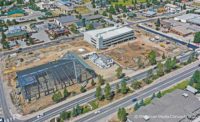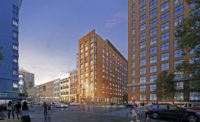Decades of history, hurricanes and all-night parties have taken a toll on the French Quarter in New Orleans. The condition of underground infrastructure has been in decline for years, so the city wanted to repair and upgrade century-old utilities along eight blocks of Bourbon Street.
“It’s an important project because this is a massive part of New Orleans history,” says Ramsey Green, deputy CAO of infrastructure and chief resilience officer for the city of New Orleans. “Bourbon Street is known internationally.”
The city of New Orleans drew more than 18 million tourists in 2018, and the state more than 51 million, according to tourism and travel research firm DK Shifflet & Associates.
“A lot of those people go to Bourbon Street,” Green says. “And we have businesses there that are a major driver of the local economy. We needed a safer, better street and drainage system.”
But soon after crews began renovation of the street in April 2017, unforeseen conditions surfaced. The discovery of abandoned drain lines and other obstructions forced the project team to expand its scope from a series of quick repairs to underground pipes into a massive reconstruction of the street and its utilities, more than tripling project costs and delaying completion by over a year and a half.
Now, more than two years later, the city of New Orleans and its project team have implemented new strategies that include contractor incentives, public engagement and a more efficient plan for sequencing the work to move the project along.
Infrastructure designer Mott MacDonald LLC, along with the city and its contractors and utility companies—including Entergy New Orleans for gas and electric utilities, Cox Communications and AT&T—completed the first phase, which included work on the 100 to 400 blocks, between Canal and St. Louis streets.
Originally scheduled from April to December 2017, that phase was expected to cost $6 million. But after the scope expanded, costs rose to $10.3 million and work took until January 2018.
The $9.5-million Phase 2 involves full reconstruction of the 500 to 800 blocks between St. Louis and Dumaine streets. Utility work began in April and is more than halfway complete.
Underground Discoveries
Officials in New Orleans Mayor Mitch Landrieu’s administration examined logs of service requests to the city and the New Orleans Sewerage & Water Board.
“We noticed there were quite a few complaints, so we decided to take a look underground,” says Josh Hartley, deputy director of operations for the New Orleans Dept. of Public Works. “In most cases, it had been over 100 years since these utilities had been touched. Looking at the condition of the utilities, we realized we had to grow the scope significantly and turn this into a full reconstruction of Bourbon Street.”
The expanded scope called for replacing drain lines, catch basins and water lines as well as sewer replacement and repairs. The city also is upgrading pavements, curbs and sidewalks, adding ADA-compliant ramps and removable street-closure posts at every intersection.
The project calls for more than 3,200 tons of concrete, approximately 189,000 bricks and more than 74,000 linear ft of utilities such as drain lines, water and sewer lines and electrical conduit.
“The most challenging part of the design was just the huge number of unknown existing utilities below the roadway,” says Many Heymann, principal engineer with Mott MacDonald.
“But when you get a great set of plans from an engineer or designer who responds instantly to resolve any unforeseen obstacles, it keeps the project moving and on schedule,” says Chris McLellan, director of construction development and a partner with Hard Rock Construction LLC, the contractor for both phases of construction.
Lessons Learned
Construction had already begun by the time the project’s challenges surfaced. Utility companies became involved so they could replace their own infrastructure, but that led to multiple contractors working in the same small footprint. Coordinating access and materials deliveries slowed progress significantly.
When New Orleans Mayor LaToya Cantrell’s administration took office in May 2018, the city and the project team announced “an entirely new approach” to the second phase. “We needed to do better for Phase 2,” Green says.
A major lesson learned from the first phase was to make sure multiple contractors weren’t working concurrently on the same block. At one point during Phase 1, four blocks of Bourbon Street were shut down at the same time. For the second phase, the city restricted work to one block—or occasionally two blocks—at a time.
“In most cases, it had been over 100 years since these utilities had been touched.”
– Josh Hartley, Deputy Director, City of New Orleans Dept. of Public Works
To avoid conflicts, Entergy began its gas and electric work for the second phase in May, about four months ahead of the city and its contractors. When the city began work in September, the utility companies were working a block and a half ahead.
The team performed exploratory work to identify existing utilities beneath Bourbon Street. The last record of excavations dated back to 1928. In Phase 2, crews cut 5-ft-wide trenches across the roadway, two per block and one in each intersection.
“We would open up the roadway and have our surveyors perform a full topographic survey on all the exposed utilities, including all measurements and sizes,” Heymann says. The engineer input that information into a 3D model.
During excavation, the project team was surprised by how many unmapped utility lines they discovered. For example, one block of Bourbon Street exposed two or three inactive water lines no one knew existed.
During the first exploratory excavation at Iberville Street, crews uncovered old cast-iron pipe that none of the utilities could identify as their own. It turned out to be an inactive water line that predated a working line installed in that block in 1928.
Crews also uncovered streetcar ties identified by a local historian as belonging to the mule-drawn Desire streetcar line from the 1840s.
All utilities had to remain in working order during excavation and improvements. “You couldn’t just put a new utility where the old one was,” Heymann says.
Space was limited. Crews had 22 ft, the width of the street, for their work area behind the construction fence. “The tight tolerances out here were unbelievable,” Heymann says. “As a civil engineer, you typically don’t deal with tolerances in inches.”
The number of obstructions meant that all drainage structures and manholes had to be custom designed. Catch-basin guards were sized to stop trash like plastic cocktail containers while allowing enough rainwater through to prevent street flooding.
New Strategies
To avoid further delays and cost increases in the second phase, the city opted for more traditional public bidding and selected the lowest bidder, Hard Rock Construction.
The Phase 1 agreement was written as part of a city maintenance contract. But in Phase 2, the city implemented a capital construction contract to incentivize on-time delivery, with liquidated damages of $3,000 for every day the project was late, not including weather delays.
City and project representatives also wanted to keep neighbors and businesses informed and make sure they were not adversely affected. Most of the second phase work took place in fall and winter, the busiest time of year in the French Quarter.
“In the world of civil engineering, it’s like building the Queen Mary. And you’re doing this while residents and businesses need to get in and out, get their trash picked up and get deliveries. It’s a unique challenge,” Green says.
The team decided to stop work for two weeks during Mardi Gras. Crews removed all labor and materials, including fencing, from the site on Feb. 18, then temporarily backfilled trenches ahead of the carnival season to minimize pedestrian and traffic disruption.
But the two week shutdown turned into more than three months as rising water levels in the Mississippi River forced the team to halt construction. The U.S. Army Corps of Engineers allowed crews to resume work at 750 Bourbon on May 20 after river levels dropped to safe levels.
Work is expected to be complete in September.







